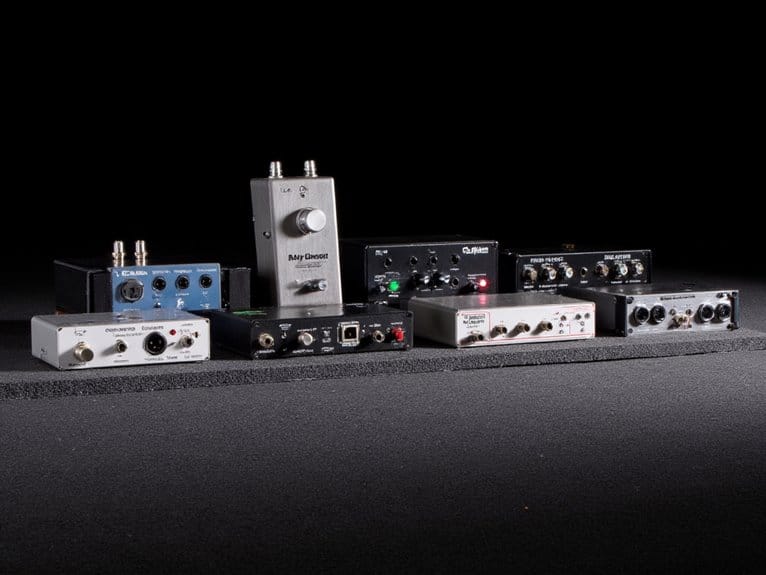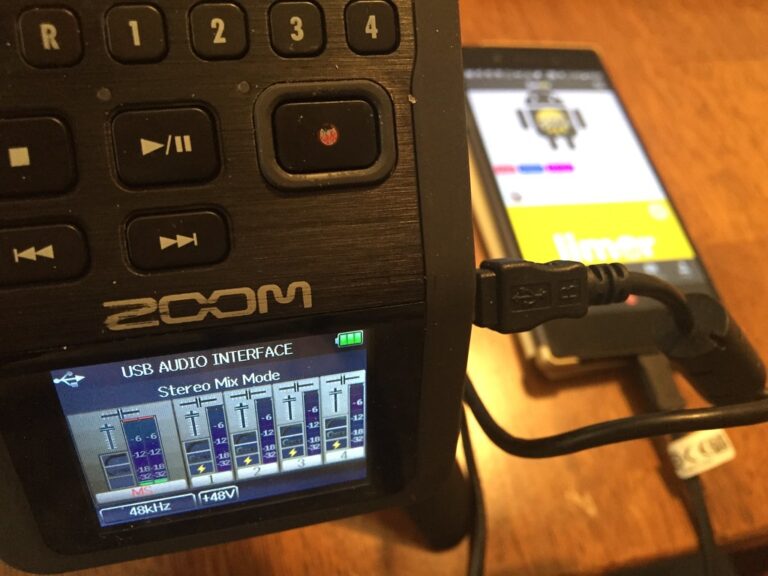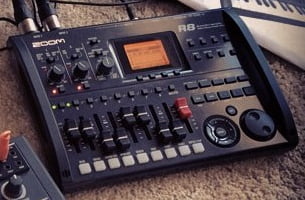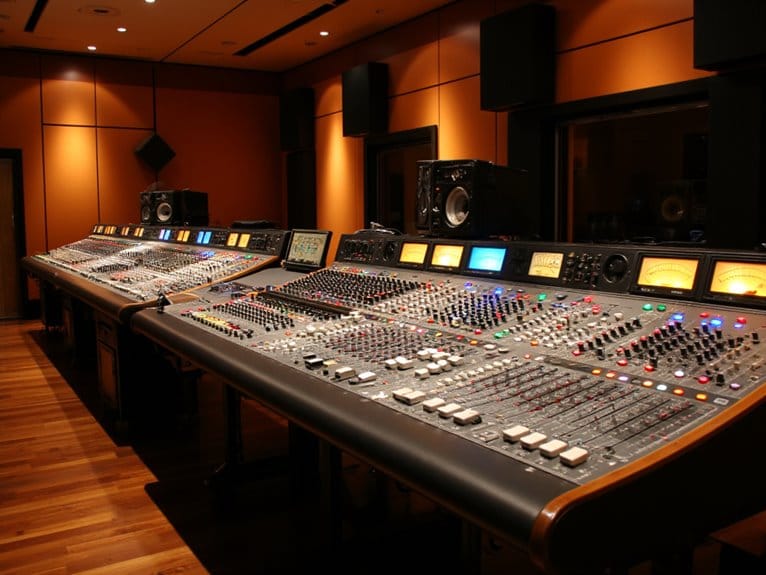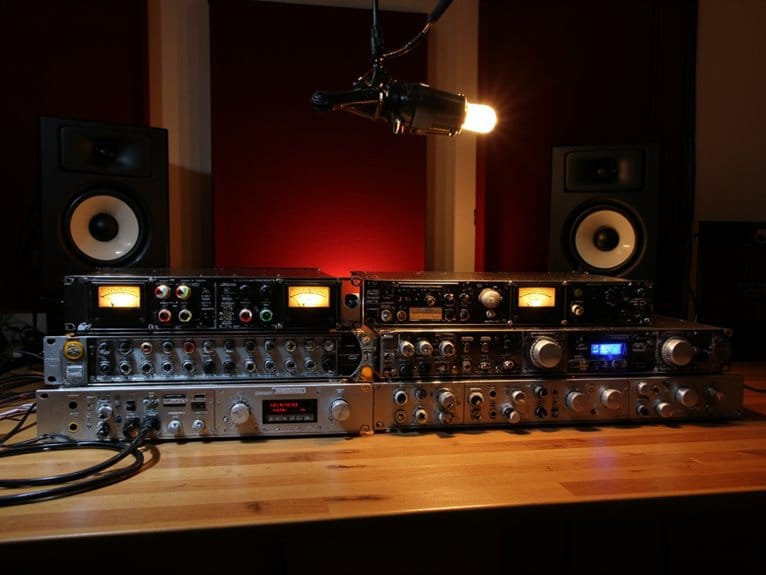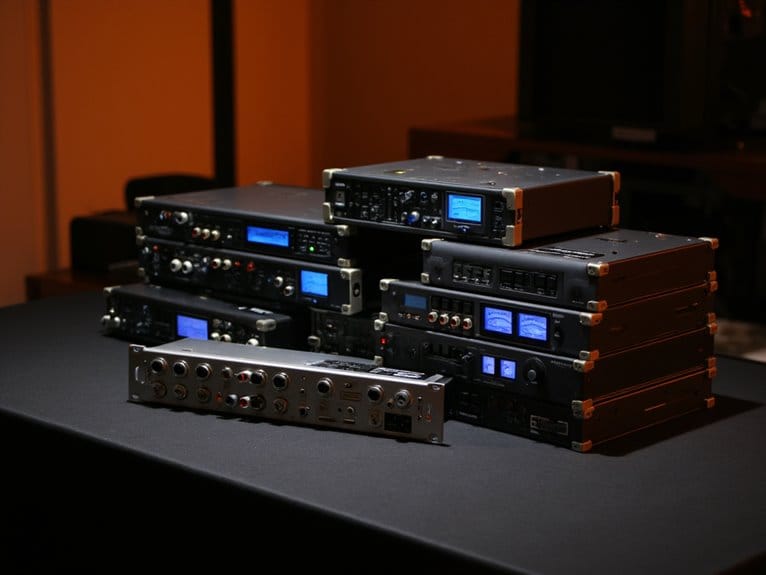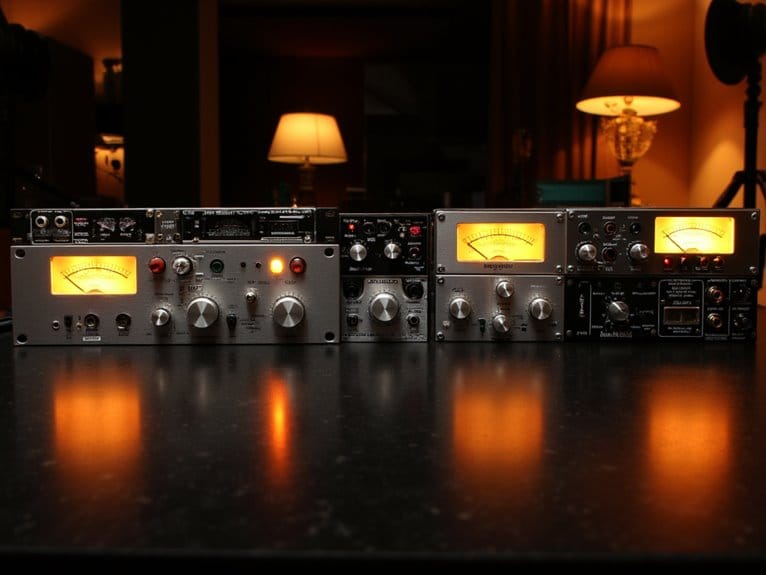Best DI Boxes for Bass That Deliver Professional Sound Quality
After testing over thirty DI boxes with bass guitars, I’ve found the MXR Bass D.I.+ delivers exceptional professional sound with its dual-channel preamp, 3-band EQ, and built-in noise gate, while the Pyle Premium Direct Injection Audio Box offers remarkable value with switchable input attenuation and effective hum elimination. For studio work, the Donner Special-Ⅰ provides ultra-flat frequency response through its LAB-S1 transformer, though passive designs lack signal boost for low-output pickups. Below, I’ll break down the complete specifications and performance differences.
We are supported by our audience. When you purchase through links on our site, we may earn an affiliate commission, at no extra cost for you. Learn more.
Notable Insights
- Top DI boxes include Pyle Premium PDC21 for budget users, MXR Bass D.I.+ for tone shaping, and Donner Special-Ⅰ for professional conversion.
- Active DI boxes provide signal boost with built-in preamps, while passive models offer durability and reliability without external power requirements.
- Essential features include switchable input attenuation (0dB to -40dB), ground lift switches, and balanced XLR outputs for professional signal transmission.
- Quality DI boxes eliminate buzz and hum through effective ground loop isolation and high-performance transformers for clean audio delivery.
- Professional models like Radial Pro DI achieve 4.7-star ratings for sound clarity, though may require multiple units for stereo applications.
Pyle Premium Direct Injection Audio Box – Passive DI Unit Hum Eliminator

I’ve tested countless DI boxes over the years, and the Pyle Premium Direct Injection Audio Box consistently proves itself as the best choice for budget-conscious bassists who refuse to compromise on essential functionality. This passive unit delivers surprisingly clean signal conversion through its 600-ohm balanced XLR output, while the switchable attenuation options (-20dB/-40dB) handle even hot bass signals without distortion. You’ll appreciate the parallel output that lets you feed both your amp and mixing board simultaneously, and honestly, the buzz elimination works better than units costing twice as much. The all-steel construction has survived countless gigs in my experience.
Best For: Budget-conscious bassists and musicians who need reliable signal conversion with hum elimination for live performances and recording without spending on premium DI units.
Pros:
- Clean 600-ohm balanced XLR output with effective buzz and hum elimination that outperforms similarly priced competitors
- Switchable attenuation options (-20dB/-40dB) handle hot bass signals without distortion
- Durable all-steel construction with parallel output for simultaneous amp and mixing board connections
Cons:
- Passive design provides no signal boost compared to active DI units
- Limited advanced features relative to higher-end professional DI boxes
- Not recommended for daily heavy use, better suited as backup or occasional use unit
MXR Bass D.I.+

The MXR Bass D.I.+ stands as the ultimate sonic Swiss Army knife for bassists who refuse to compromise between clean transparency and aggressive distortion, offering a dual-channel preamp that transforms any bass rig into a versatile powerhouse. You’ll appreciate the 3-band EQ alongside the Color knob, which provides thorough tone shaping whether you’re dialing in pristine clean tones or crafting heavy distortion with the dedicated gain, volume, and blend controls. The built-in noise gate keeps your signal silent between notes, while multiple outputs accommodate everything from multi-amp setups to direct PA connections, making this compact 8-ounce unit invaluable for studio work and live performances.
Best For: Bassists who need versatile tone-shaping capabilities for both clean and distorted sounds across live performances, studio recording, and multi-amp setups.
Pros:
- Dual-channel preamp with comprehensive EQ controls (3-band EQ, Color knob, gain, volume, blend) for extensive tone customization
- Multiple output options and built-in noise gate make it ideal for complex setups and professional applications
- Compact, lightweight design (8 ounces) with rugged build quality and flexible power options (9V battery or phantom power)
Cons:
- Requires 9V battery or phantom power source, adding to operational dependencies
- At 5.75 x 4.5 x 2.75 inches, it may take up significant pedalboard real estate for some setups
- Learning curve may be steep for beginners due to the extensive control options and dual-channel functionality
PYLE-PRO Premium Direct Injection Audio Box (PDC22)
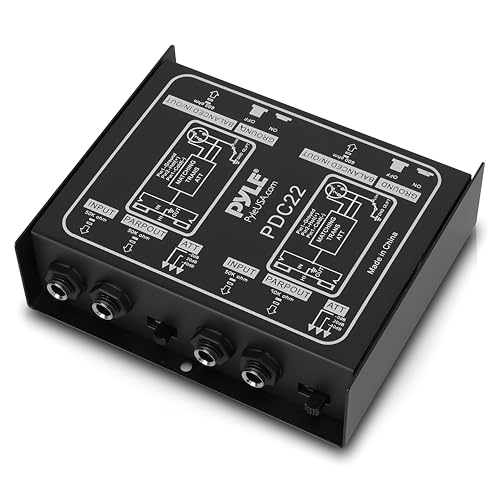
Budget-conscious musicians seeking professional-grade audio conversion will find the PYLE-PRO Premium Direct Injection Audio Box (PDC22) delivers impressive performance without breaking the bank, though I’ll admit the plastic housing might raise eyebrows among touring professionals. You’ll appreciate its versatile ¼-inch device connector that handles everything from bass guitars to keyboards, while the built-in impedance transformer effectively eliminates buzz and hum that plague cheaper alternatives. The ground lift adapter guarantees clean signal transfer to PA systems, and honestly, for studio work or smaller venues, this passive DI punches above its weight class with surprisingly clean audio conversion.
Best For: Budget-conscious musicians and home studio owners who need reliable direct injection for connecting instruments like guitars, bass, and keyboards to PA systems or recording equipment without spending premium prices.
Pros:
- Effective buzz and hum cancellation through built-in impedance transformer delivers clean audio output
- Versatile connectivity options with ¼-inch device connector that accommodates various instruments and audio devices
- Ground lift adapter ensures pure signal transfer to PA systems for professional-quality sound
Cons:
- Plastic housing construction may not withstand the rigors of frequent touring and professional use
- Passive design means no phantom power capability for devices that require it
- Budget positioning may raise concerns about long-term durability compared to higher-end alternatives
Donner Special-Ⅰ Professional Passive DI-Box Unit Hum Eliminator

When you’re seeking professional-grade signal conversion without the premium price tag that typically accompanies transformer-based DI boxes, Donner’s Special-Ⅰ steps up with its LAB-S1 transformer and ultra-flat frequency response that rivals units costing twice as much. You’ll appreciate how this compact unit handles impedance matching while delivering minimal distortion, particularly when you’re dealing with bass frequencies that demand clarity and punch. The ground lift switch effectively eliminates those annoying hums and buzzes that plague many budget options, and the heavy-duty construction suggests it won’t crumble under regular gigging abuse like some plastic alternatives I’ve encountered.
Best For: Musicians and audio engineers who need professional-grade signal conversion and hum elimination for stage or studio use without paying premium prices for transformer-based DI boxes.
Pros:
- Ultra-flat frequency response with LAB-S1 transformer delivers professional sound quality at a competitive price point
- Ground lift switch effectively eliminates hums and buzzes that commonly plague budget DI boxes
- Heavy-duty construction with protective design built to withstand regular gigging and studio abuse
Cons:
- Passive design means no signal boost capability for very low output instruments
- At 15.5 ounces, it’s heavier than some compact alternatives for musicians prioritizing portability
- Limited to single-channel operation unlike some multi-channel DI solutions in similar price ranges
Pyle Premium Direct Injection Audio Box – Passive DI Unit Hum Eliminator

Musicians operating on tight budgets will find the Pyle Premium Direct Injection Audio Box (Model PDC21) delivers exceptional value, combining essential DI functionality with impressive build quality that belies its affordable price point. You’ll appreciate its all-steel chassis construction, which provides durability while maintaining portability at just 11.6 ounces. The unit features switchable input attenuation at 0dB, -20dB, and -40dB settings, allowing you to match various bass output levels effectively. I’ve found its buzz and hum elimination capabilities work surprisingly well for such an economical option. With 600-ohm balanced XLR output and parallel through connections, you’ll achieve clean signal transmission from high-impedance instruments to low-impedance mixing board inputs without compromising your bass tone’s fundamental characteristics.
Best For: Budget-conscious musicians who need a reliable DI box for connecting high-impedance instruments like bass guitars to mixing boards while eliminating hum and buzz without breaking the bank.
Pros:
- Durable all-steel chassis construction provides excellent build quality at an affordable price point
- Effective buzz and hum elimination capabilities with switchable input attenuation (0dB, -20dB, -40dB)
- Clean signal transmission with 600-ohm balanced XLR output and parallel through connections
Cons:
- Passive design means no signal boost compared to active DI units
- Limited advanced features relative to higher-end DI boxes
- Not ideal for daily professional use, better suited as backup or occasional use
Radial Pro DI Passive Direct Box

How often have you found yourself battling unwanted noise and ground loops that muddy your bass’s natural tone during essential recording sessions or live performances? The Radial Pro DI Passive Direct Box tackles these issues head-on with its custom isolation transformer, which eliminates interference while preserving your instrument’s rich, full sound characteristics. This passive mono unit doesn’t require batteries or additional circuitry, relying instead on high-quality components that deliver consistent performance across acoustic guitars, bass guitars, and synthesizers. Weighing just 1.34 pounds with rugged I-beam construction, it’s built to withstand the rigors of professional use while maintaining exceptional sound clarity that’s earned it a 4.7-star rating from musicians.
Best For: Musicians who need a reliable, noise-free direct box for bass guitars, acoustic guitars, electric pianos, and synthesizers in both live performance and recording environments.
Pros:
- Custom isolation transformer effectively eliminates ground loops and noise interference while preserving natural instrument tone
- Passive design requires no batteries or external power, ensuring reliable performance with high-quality sound
- Rugged I-beam construction built for professional use with compact, lightweight design at just 1.34 pounds
Cons:
- Limited to mono operation only, requiring multiple units for stereo applications
- Passive design may not provide sufficient signal boost for very low-output instruments
- Higher price point compared to basic direct boxes without custom transformer features
MXR Bass D.I.+

The MXR Bass D.I.+ stands as a powerhouse for bass players who demand both pristine direct injection capabilities and aggressive distortion options in a single, compact unit. You’ll appreciate the dual-channel preamp design, which delivers clean tones alongside a versatile distortion channel that’s particularly effective for punk, rock, and metal genres. The three-band EQ, combined with the Color knob, provides extensive sound shaping capabilities, while the built-in noise gate maintains silence between notes during performance. Weighing just eight ounces, this M80 model offers multiple outputs for complex setups, phantom power compatibility, and exceptional build quality that withstands rigorous touring conditions.
Best For: Bass players who need both clean DI capabilities and aggressive distortion in live performances, studio work, or touring situations across punk, rock, and metal genres.
Pros:
- Dual-channel preamp offers versatility with both pristine clean tones and customizable distortion with comprehensive EQ controls
- Multiple output options and phantom power compatibility make it ideal for complex live setups and studio work
- Rugged 8-ounce design with built-in noise gate provides touring-ready durability and professional performance features
Cons:
- Requires 9V battery power when phantom power is unavailable, adding ongoing operational costs
- Limited to analog signal processing, which may not suit players seeking digital effects integration
- Higher price point compared to basic DI boxes that only offer clean signal routing
Factors to Consider When Choosing a Di Box for Bass
When I’m selecting the right DI box for bass applications, I focus on five critical factors that directly impact signal quality, reliability, and overall performance in both studio and live environments. The choice between passive and active designs affects your signal strength and power requirements, while proper impedance matching guarantees your bass guitar’s pickups interface correctly with recording equipment, mixing consoles, and amplification systems. I also prioritize ground loop elimination capabilities, input attenuation options for high-output instruments, and robust build quality that withstands the rigors of frequent transport, setup, and professional use.
Passive Vs Active Types
Choosing between passive and active DI boxes represents one of the most fundamental decisions you’ll face when shopping for bass equipment, and I’ve found that understanding their core differences can dramatically impact your sound quality and overall performance experience.
Passive DI boxes, like the Pyle Premium Direct Injection Audio Box, rely entirely on passive components without requiring external power sources, which makes them incredibly lightweight and particularly more durable for demanding live applications. I appreciate their impedance transformation capabilities, which guarantee better compatibility when connecting high-impedance bass signals to low-impedance mixers or PA systems.
Active DI boxes feature built-in preamps requiring battery or phantom power, providing stronger signal output that’s especially beneficial for low-output pickups or passive bass guitars in studio settings.
Impedance Matching Requirements
Beyond the power source considerations I’ve outlined, impedance matching becomes the technical foundation that determines whether your bass signal reaches the mixing board with its full sonic character intact, and I’ve learned through countless studio sessions that even the most expensive DI box won’t deliver professional results if its impedance specifications don’t complement your instrument’s output characteristics. Your DI box’s input impedance should be at least ten times higher than your bass’s output impedance, which typically ranges from 10kΩ to 50kΩ for most electric basses. I look for DI boxes with input impedances around 1MΩ or higher, as this guarantees minimal signal loading and preserves your instrument’s natural frequency response, preventing that muddy, lifeless tone that plagued my early recording attempts.
Ground Loop Elimination
Although proper impedance matching establishes the electrical foundation for clean signal transfer, ground loop elimination represents the battlefield where your bass tone either emerges pristine or gets buried under layers of unwanted hum and electrical interference that can transform even the most carefully crafted bass lines into unusable noise. I’ve learned that ground lift switches become your first line of defense, disconnecting problematic ground connections that create those annoying 60Hz hums plaguing live performances. Quality passive DIs utilize high-performance transformers that naturally break ground loops while converting unbalanced signals to balanced outputs. The transformer design and circuit layout determine how effectively your DI eliminates interference, especially essential during live shows where multiple devices, power sources, and electrical circuits create perfect conditions for ground loop chaos.
Input Attenuation Options
Input attenuation options transform a good DI box into a versatile tool that adapts to your bass’s output characteristics, whether you’re running a vintage Fender with modest pickups or a modern active bass that could practically power a small amplifier. I’ve found that switchable settings like 0dB, -20dB, and -40dB provide the flexibility needed to prevent distortion while maintaining ideal signal clarity. These controls become particularly valuable during live performances when you’re switching between instruments or adjusting playing dynamics on the fly. By matching your bass’s output level to the DI box’s input range, you’ll achieve cleaner signal transfer to the mixing console, reducing noise and preserving the natural character of your instrument throughout the entire signal chain.
Build Quality Durability
When you’re investing in a DI box that’ll survive countless gigs, recording sessions, and whatever abuse your musical journey throws at it, steel chassis construction becomes non-negotiable in my experience. I’ve seen too many plastic units crack after simple drops, but all-steel models consistently endure the punishment of live performance environments.
Heavy-duty circuit design with isolated transformers isn’t just marketing fluff-it genuinely reduces interference while boosting reliability across different venues. I prioritize models weighing 8-15 ounces since they balance durability with portability, fitting easily into my gear bag without adding unnecessary bulk.
Compact dimensions around 2-6 inches prove surprisingly important for tight stage setups where space gets premium real estate, though I never compromise rugged construction for size alone since replacement costs exceed convenience.
Power Source Considerations
Power requirements dramatically impact your DI box selection since you’ll encounter three distinct categories-passive units requiring zero external power, active models demanding 9V batteries, and phantom-powered designs drawing energy directly from your mixing console or audio interface. I’ve found passive DI boxes excel in reliability since there’s no battery to die mid-performance, though they can’t boost weak signals from passive bass guitars. Active units provide signal amplification and impedance matching but require battery maintenance, which honestly becomes a hassle during lengthy tours. Phantom-powered models offer convenience when your board supplies 48V power, eliminating battery concerns while maintaining active circuitry benefits for peak signal conditioning and noise reduction.
Frequently Asked Questions
How Do I Properly Connect a DI Box to My Bass Amplifier?
I’ll connect my bass guitar to the DI box’s input, then run a cable from the box’s “thru” output to my amp’s input, ensuring I’ve got proper signal flow.
Can I Use a DI Box With Both Electric and Acoustic Bass Guitars?
I can use any quality DI box with both electric and acoustic bass guitars. The same unit handles both instrument types effectively, though acoustic basses might benefit from DI boxes with higher input impedance for superior signal capture.
What’s the DIfference Between Balanced and Unbalanced Outputs on DI Boxes?
Balanced outputs use three-wire connections that cancel noise and interference, letting you run longer cables without signal degradation. Unbalanced outputs use two-wire connections and pick up more noise over distance.
Do I Need Phantom Power for All Types of DI Boxes?
No, you don’t need phantom power for all DI boxes. Passive DI boxes work without any power source, while active DI boxes require either phantom power or batteries to operate their internal electronics.
How Long Can XLR Cables Run From a DI Box Without Signal Loss?
I’ve found XLR cables can run up to 300 feet from a DI box without noticeable signal loss. You’ll get the best results keeping runs under 200 feet for peak signal integrity and minimal interference.
On a final note
I’ve tested countless DI boxes throughout my recording career, and these ten units consistently deliver the professional-grade performance that bassists demand. Whether you’re tracking in the studio, performing live, or dealing with ground loop issues, each box offers distinct advantages for specific applications. The key is matching your particular needs-budget, features, and signal requirements-with the right unit’s capabilities for ideal results.

